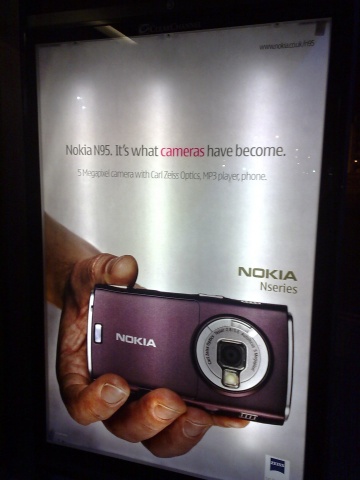Part of the reason is that the new phones don't seem to have anything new on them. Of course this isn't strictly true, all the spec sheets will show that there have been improvements in areas, the numbers will be a little bigger where they need to be, smaller in other areas where they need to be, and factually all will be new. And there is the “new car smell” of a straight out the factory handset.

The E90 coped with the Fringe in 2007, why wouldn't it suffice in 2009?
But new handsets seem to be providing diminishing returns on an emotional level. There's nothing genuinely new to the current and upcoming crop of smartphones, just a general feeling of “things are a little bit better than before”. Perhaps this is why the plethora of 18 month and 24 month long contracts in the UK mobile market doesn't perturb me. The pace of change, at least in the eyes of the consumer, has slowed down.
 Of course, the underlying software is changing at a fast rate, but with most handsets from manufacturers having the ability to be flashed at home or over the air, there is less need to send out new handsets and have code changes churned into the eco-system. The smart users are doing the work for the networks and carriers by going OTA themselves.
Of course, the underlying software is changing at a fast rate, but with most handsets from manufacturers having the ability to be flashed at home or over the air, there is less need to send out new handsets and have code changes churned into the eco-system. The smart users are doing the work for the networks and carriers by going OTA themselves.
Where there are differences, and the potential interest to making new devices feel new, is the form factor. This last year has seen a variety of S60 devices trying out new looks, from the tablet-esque Nokia 5800, the Blackberry-styled E71, the side-slider format in the E75, and of course the Commuicator-like N97 (which to be honest is more like the Nokia Maemo N810 tablet than the E90 or 9500's, which are the true communicators). Hardware is not so easily kept up to date as software, but most people, I suspect, have found their niche form factor now, and it would take a lot to make people change just to try another construction outcome.
What has changed are the addressable applications. The last true 'must have' piece of technology that had to be integrated into smartphones was the GPS – it's now almost at the point where it's specifically noted only if a smartphone does not have the technology inside it. There are some new areas that could become the next big thing (Near Field Communications is probably the nearest to maturity, but is there a pressing case for people to have NFC or any other bleeding edge tech)? More importantly, GPS had a perception that it was important enough to upgrade for. I doubt you can say the same for NFC, or a slightly better camera, or any of the other spec inflation that seems to drive upgrades.
I can see the power users now pointing at the Samsung iWhateverItsCalledThisWeek, but a few thousand sales to the geeks does not make a market. You need to be able to constantly sell hundreds of thousands of units a month to have a real impact. Right now I don't see anything in the current range of smartphones (Symbian or otherwise) that is enticing enough.
These small improvements are not delivering enough momentum to get me to voluntarily move away from my existing handset, and given the regularity of handset changes I've had in the last ten years, and how excited I've been to pick up those new handsets, that's a big statement. In part it's because Symbian and Nokia have finally got all the little niggles sorted out and filled in all the obvious software gaps.
So where do they go from here? Perhaps someone (or something) will thrill me for Q3/Q4 this year, because while changes to make code Open Source, or slightly faster in paging graphics to the screen have the potential to get me excited, that's not something you can advertise with a bullet point in a high street store.
-- Ewan Spence, June 2009.
